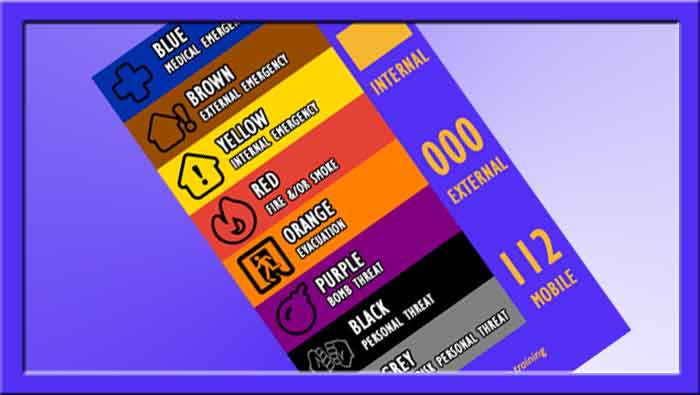Introduction
Emergency situations in healthcare facilities demand swift and efficient responses. To ensure the safety of patients, staff, and visitors, Australian healthcare institutions adhere to specific emergency colour codes as outlined in Australian Standards AS3745 and AS4083 (the two primary Australian standards that provide a framework for developing responses to internal and external emergencies).
These colour codes, each denoting a distinct emergency scenario, play a crucial role in guiding emergency procedures, enabling a coordinated response, and safeguarding lives. In this comprehensive guide, we will delve into the significance of these emergency colour codes and how they are integrated into the emergency plans of healthcare institutions.
| Colour | Symbol | Emergency Code | RGB |
| Red |  | Fire or Smoke | (227, 66, 52) |
| Purple |  | Bomb Threats | (128, 0, 128) |
| Blue |  | Medical Emergency | (0, 47, 167) |
| Yellow |  | Internal Facility Emergency (e.g., Power Failure) | (255, 215, 0) |
| Brown |  | External Emergency (e.g., Bushfire) | (150, 75, 0) |
| Orange |  | Evacuation | (255, 127, 0) |
| Black |  | Personal Threat (e.g., Physical Violence) | (0, 0, 0) |
| Grey |  | Lower Risk Personal Threat (e.g., Threatening Behaviour) | (128, 128, 128) |
Additional Resources:
Understanding Emergency Colour Codes
Red for Fire or Smoke
The colour red signifies a fire or smoke emergency. In hospitals, where patient safety is paramount, swift action is necessary. Staff, trained according to the Australian Standard AS4083, respond promptly to contain the fire, ensuring occupant or patient care is not compromised.
Purple for Bomb Threats
A purple alert indicates a bomb threat, requiring meticulous evaluation and coordination with local authorities. Hospitals must have protocols in place, aligning with AS3745, to assess the threat and evacuate if necessary, ensuring the safety of all occupants.
Blue for a Medical Emergency
Code blue is universally recognised as a medical emergency. In Australian emergency medical and aged care facilities, this code prompts immediate response from medical professionals, indicating a cardiac arrest or other life-threatening situations.
Yellow for an Internal Facility Emergency
Yellow is employed for internal facility emergencies such as power failures. Hospitals must prepare for these situations, ensuring backup power systems are in place and critical equipment, including emergency lighting, cardiac monitors and life support machines, remain functional.
Brown for an External Emergency
In Australia, where bushfires pose a significant threat, the brown code is essential. It signifies an external emergency, prompting hospitals to follow AS3745 guidelines to safeguard patients and staff, potentially evacuating if the situation escalates.
Orange for Evacuation
An orange alert indicates the need for evacuation. Hospitals adhere to AS3745 and AS4083, meticulously planning evacuation routes, ensuring accessibility, and appointing coordinators and wardens to oversee the process, guaranteeing a safe exit for all.
Black for a Personal Threat
The black code denotes a personal threat, necessitating immediate action to protect staff and patients from physical violence. Hospitals employ AS3745 procedures to manage these situations, ensuring the safety of all occupants while involving law enforcement if required.
Grey for a Lower-Risk Personal Threat
Grey indicates a lower-risk personal threat, like threatening behaviour. Hospitals employ AS3745 protocols to assess the situation, ensuring the safety of all individuals involved, and implementing appropriate measures to de-escalate the threat.
Implementing Hospital Emergency Codes like Code Blue in Healthcare & Care Facilities in Australia

Compliance with Standards
Healthcare facilities are mandated to adhere to Australian Standard AS 4083, which provides a comprehensive framework for developing and implementing their emergency procedures manual which covers compliance with these standards ensures that patient care facilities are adequately prepared to handle a wide range of emergencies, including building fire safety, effectively.
Training and Education
Hospital staff members receive regular training to respond to an alarm and notify or respond appropriately to various codes used in hospitals and other facilities. This training covers the identification of codes, the protocols to follow, and the vital role each staff member plays in ensuring the safety of patients and colleagues.
Integration with Emergency Plans
Colour codes form an integral part of the hospital’s emergency plan, guiding staff and emergency control organisations on how to respond to specific situations. Hospitals incorporate these codes into their emergency manual from AS 4083 and AS 3745 set out the requirements for ensuring a coordinated response during crises.
Regular Drills and Assessments
To maintain preparedness, healthcare facilities conduct regular emergency exercises. These drills, give an opportunity to test the codes based on AS3745 guidelines, assess the effectiveness of the emergency manual, identify areas for improvement, and ensure that personnel are well-versed in responding to different emergency situations every year.
Conclusion
Colour codes are a fundamental aspect of emergency management in healthcare facilities. By adhering to the guidelines set forth in Aus Standards AS3745 and AS4083, hospitals can effectively respond to various emergencies, ensuring the safety and well-being of patients, staff, and visitors. Through rigorous training, meticulous planning, and a commitment to compliance, Healthcare institutions stand prepared to handle any emergency situation that may arise.
